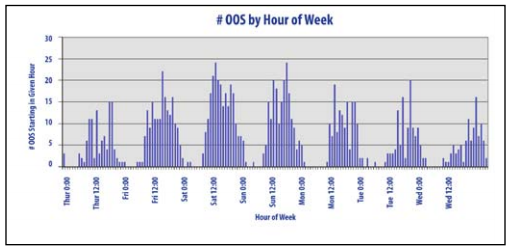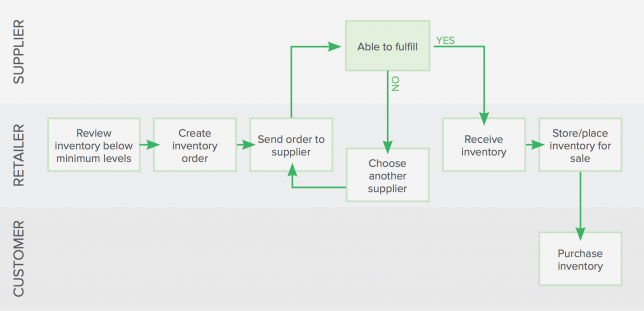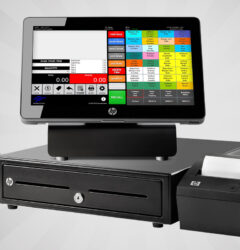25 Aug

Stockouts almost always make it to the “worst nightmare” lists of retailers, and for good reason. Not only do they lead to lost sales, but out-of-stocks also result in reduced customer satisfaction and lower loyalty levels. Shoppers often feel let down when you don’t have what they’re looking for, and the last thing you want is to disappoint customers.
Fortunately, though, there are a number of solutions to your out-of-stock woes. Many causes of stockouts can be prevented by taking steps to better understand your business and products, and by refining your store’s processes.
To give you a better idea of how you can accomplish this, below are 5 common causes of stockouts and pointers on how you can sidestep them:
1. Inaccurate data
It’s very easy to run into inaccuracies when dealing with inventory. Between shipment variances, misplaced products, returns, and stolen goods, retailers find that the inventory numbers they have on paper (or on screen) often don’t match what they have in their stores.
Such discrepancies can lead to merchants mistakenly thinking that they have an item in stock when they don’t, so they end up re-ordering the wrong products or quantities.
How can you address this? Consider the following:
a. Use a modern inventory system
The first step to avoiding discrepancies is to implement an electronic (ideally cloud-based) inventory system. Keeping track of products using a pen and paper isn’t just time-consuming, it can also lead to mistakes.
It’s best to use a point-of-sale or inventory system that automatically modifies inventory levels as you ring up sales, so you won’t have to worry about manually updating your database. Such solutions are also beneficial if you have several locations because they allow you to manage multiple stores from one place.
Not ready for a full retail management solution? Consider creating an inventory management system in Excel. It’s easy, basic, and it can give you the data you need to spot inventory inaccuracies.
b. Integrate your platforms
If you’re selling through multiple channels, be sure to connect all your retail platforms. This typically means integrating your POS system with your ecommerce site.
Doing so helps ensure that all your catalogs are in sync and that stock levels are updated every time you make a sale. After all, the last thing you want is to sell something online that isn’t physically available in your stores or warehouse.
c. Stay organized and vigilant
Modern inventory systems can only go so far. While a nifty solution can keep your databases synced, it can’t deter shoplifters nor can it stop suppliers from delivering the wrong quantities.
This is where your diligence and organizational skills will come in. Get to the root of your inventory discrepancies. Is it an issue with your vendors? Are you dealing with theft? Whatever the case, find the reasons why the numbers aren’t adding up and take the necessary steps to stop them.
If it’s a matter of vendor discrepancies, for example, you may want to make changes with how deliveries are handled in your store. Perhaps you need to reschedule shipments to make sure that deliveries don’t happen all at once, or maybe you need to assign someone to double check the packing slips.
Dealing with theft? It could be time to upgrade your security system or re-arrange your store to make it easier for associates to keep an eye on shoppers.
d. Consider RFID (Radio Frequency Identification)
Other retailers are taking on a more hi-tech approach when it comes to maintaining inventory accuracy. Many are now using RFID–a technology that can store and track product information using a chip embedded in an item’s tag or packaging.

RFID enables merchants to monitor and search for merchandise using a handheld scanner (see image above), making it faster and easier for them to track down where each item is.
“People manually counting items in the supply chain take too much time; it is too expensive and is also fraught with error,” writes Will Roche of Xterprise on RetailSoulutionsOnline.com. According to him, RFID technology is the top solution for inventory data inaccuracies, especially for apparel and footwear retailers.
e. Conduct regular stock counts
You can’t have accurate numbers if you’re not tracking and updating them. While modern inventory systems can do a great job at keeping your stock levels in check, you still need a handle on the amount of physical inventory that you have.
That’s where physical inventory counts come in. Set aside time to count your products and ensure that what you have on paper matches up with what’s actually in-store or in your backroom.
Retailers typically have two options when it comes to stock counts: full inventory counts or cycle counting.
With full inventory counts, you’ll need to set aside several hours to count every item that’s in your store. You can choose to do it after you close for the day, but if that’s not enough, you may have to halt operations for about half a day or so. (Be sure to notify your customers beforehand!)
If you’re not keen on closing your store, then cycle counting might be a better option. This method entails counting and checking just a small selection of SKUs daily until you’re able to “cycle count” through your entire catalog. It allows you to stay on top of stock counts without having to close your store.
The “right” method depends on each store, so see which practice works best for you. But whether you decide to conduct full inventory counts or you’d rather stick to cycle counting, aim to count all of your merchandise once a month, or at the very least, once every quarter.
Avoiding stockouts requires you to have near real-time information on what you have (or don’t have) on hand. You won’t be able to do that if you’re only counting your merchandise once or twice a year.
2. Failure to re-order in a timely manner
This issue is pretty straightforward: products are flying off the shelves faster than you can re-stock, and this results in you selling out of in-demand items. How can you prevent it? Here are a couple of ways:
a. Find OOS (out of stock) patterns
Try to identify OOS trends in your store. A study by P&G found that OOS “tend to form patterns such as day of week,” and retailers can find them by regularly auditing their inventory and taking note of the days and times of the week when they usually experience stockouts.
Consider the chart below

By looking at the data, it appears that OOS for this particular store peaks during Friday afternoon, Saturday at noon, and Sunday late afternoon. With this data in mind, the retailer can then schedule to have products delivered and replenished at just the right times to ensure that they don’t run into out-of-stocks.
b. Implement demand forecasting
As the term indicates, this process is all about anticipating demand so you can determine what products to order and when.
You can try to forecast demand on your own by using your judgment and factoring in stock turn, sell through, historical sales data, and other components such as promotions, seasonality, economic state, etc. Crunching these numbers should give you some insights into how products are going to perform.
One example of a retailer that forecasts demand efficiently is Christmas Elves, a holiday store in Australia.
“I have to place my Christmas orders in January or February each year, so we pretty much get one shot at purchasing. If I under-purchase and sell out then I lose sales opportunities,” he said.
According to Jason, he pays close attention to the speed at which products are selling. “I call it velocity reports. I look at how many trees are selling per week and track the sales progression over time.
”By looking at when sales spike and which products are selling the most, Jason and his team can get a clearer idea of how many units to order. Jason says he looks at sales velocity reports for specific products and their overall categories, and this allows him to figure out what items to order and if there are any related products that he could purchase.
c. Pay attention to consumer trends
Historical data is great, but you also need to pay attention to consumer trends in your market. Are there any new products that people are gravitating towards? Are there any styles that are making a comeback? Take note, then stock up accordingly.
Jason over at Christmas Elves does a great job at using trends to predict demand. According to him:
“For example, there’s this trend at the moment where customers have moved away from buying white Christmas trees, and instead are purchasing snow covered or flocked Christmas trees. In other words, fewer people are buying white and more people are buying green trees with snow on them, so it looks like a true winter wonderland.”
“Looking at sales reports allowed us to identify that trend, so we haven’t bought many white trees, and the ones we have are on sale.”
d. Set re-order points
Once you have an idea of your out-of-stock patterns and the amount of product you should have at any given time, create re-order points to ensure that you can order the right merchandise when necessary.
For best results, use a POS or inventory management solution that lets you set re-order points, so you can get notified whenever stock is running low.
3. Poor management of people, processes, and technology
You can have robust tools and solid inventory plans in place, but if you don’t have the right employees to implement them, you’re still going to run into stockout issues.
For instance, you may have sufficient stock in the backroom, but if your staff isn’t staying on top of replenishing the shelves, customers may assume that you don’t have the merchandise available. Or, your inventory system could be offering some great insights, but if your employees don’t know how to interpret the data, then they can’t put the information to good use.
Prevent such issues from happening by investing in three areas: people, processes, and technology.
Let’s start with the first one:
a. People
Invest in better training for your staff. See to it that they not only know how to work your system but that they’re also aware of what data and insights to take action on. If possible, have a vendor, technology partner, or consultant conduct the training to ensure that they get the proper education.
Also, note that investing in your staff isn’t just about training them. You also need to invest in their well being. Happy employees work harder, are more motivated, and produce better results, which is why retailers should keep finding ways to empower them.
b. Processes
Design a business flow detailing the inventory process in your store, then assign people to take on each step. Who’s in charge of receiving items? Who’s supposed to replenish your shelves? At what point should the staff reorder products, and who’s in charge of doing it?
Have everything down on paper. Doing so will help you and your staff understand the process and implement it correctly.
This is exactly what Chris Herbert and Christian Smith of TrackR did. In an article on Entrepreneur, they talked about how documenting their inventory process — from receiving a purchase to fulfillment — enabled them to stay on top of things.

c. Technology
Arm yourself (and your team) with tools that’ll make inventory-centric tasks easier.
Planograms – A lot of retailers use planograms to create visual representations of how products should be arranged in their store. Planograms are useful for merchandising purposes and can help retailers execute appealing displays. They’re also an excellent tool for staying on top of shelf inventory. By giving your staff a planogram to refer to, they can easily see if they need to replenish store shelves and if all the products are in the right place.
Inventory counting tools – Are you still using pen and paper to physically count your merchandise? Do yourself (and your staff) a favor and switch to a more modern tool instead.
Our recommendation? Scanner, a free barcode app for inventory that works on iPhone, iPad, and iPod Touch. The app lets you scan all the most common barcodes and datamatrix codes, and then it saves the name and quantity of items you scan.
From there, you can save your products into a CSV file, which you can then email to yourself or your staff. And if you’re a Vend user, Scanner automatically syncs with your account, so there’s no need to deal with CSV files and email.
In-store analytics – You could also consider more sophisticated tools such as in-store analytics solutions that let you measure foot traffic. Aside from allowing you to get to know your customers better, these tools can also help you staff your stores more effectively.
By knowing when your peak hours are, you can arrange staff schedules accordingly, and you won’t have to worry about not having enough people restocking the shelves or helping customers.
4. Poor communication or relationships with your suppliers
Failure to deal with or communicate effectively with suppliers can result in missed or delayed orders, which can then lead to stockouts.
How do you avoid all that? For starters, work on your communication. Get all order and deadlines on paper, then see to it that everyone is on the same page. You should also be prompt and let your suppliers know about any issues as early as possible.
For instance, if a product is selling faster than expected, don’t wait until is inventory is low before taking action. Get in touch with your vendors ASAP, then plan your next order.
It also helps to leverage supplier platforms that facilitate communication between you and your vendors. A good example of this is Bira Direct, a product buying group for independent retailers in the UK. Bira Direct has 200+ promoted suppliers and allows Bira members to enjoy exclusive buying terms and discounts.
Finally, consider sharing data and forecasts with your vendors, so you can both agree on product ordering and schedules.
“One way that supply chain relationships often break down in the retail industry is that product forecasting is imperfect,” says Attorney Sarah Rathke, a partner at Squire Patton Boggs.
“Retailers sometimes do not know or fail to adequately analyze, how much of a given product their consumers will likely demand over the coming buying phase. Suppliers then are left totally in the dark.”
It’s vital that you invest in the necessary forecasting tools and processes, so you and your suppliers are on the same page when it comes to the merchandise that you need.
Consider what Spreadshirt, a platform for personalized clothing and accessories, is doing. According to global apparel manager to Kristina Michniak, they “continually update and share new forecasts [with suppliers] for accurate and real-time monitoring of the global supply chain.”
5. Not enough working capital
Some businesses run into stock-outs because of lack of funds to purchase new inventory. If this is you, then you’ll need to find ways to improve cash flow. Now, each company’s financial situation is different, but here are some things you can try to free up some working capital:
a. Liquidate surplus stock
Dealing with excess stock? Try to move that inventory as soon as you can. Put them on sale or bundle them with high-performing products to get them off the shelves. If that doesn’t work, see if you can sell them to liquidation companies.
b. Collect on unpaid invoices
Do you have customers who owe you money? Get in touch and remind them about any outstanding invoices. Staying on top of on-account sales is essential, as it will allow you get much-need (and well-deserved) funds into your business.
c. Increase sales
Another way to improve cash flow? Sell more. Brainstorm ways to increase sales and revenue in your store. Is it a matter of improving your product offerings? Do you need to make your promotions more enticing? What can you do to get your existing customers to buy more?
Spend some time answering these questions. You’re bound to come up with ideas to help you generate revenue and improve cash flow.




